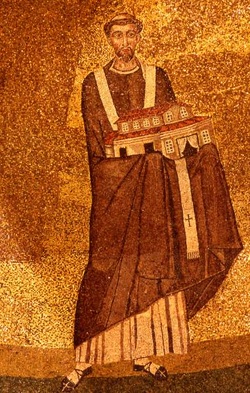
(From Makarios of Simonos Petra, The Synaxarion, (Ormylia, Chalcidice, 2003), IV, 91–96)
| The Seven Councils |
|
|
Today the Church commemorates our Father among the Saints, Sophronius, Patriarch of Jerusalem. This entry is related to my previous blog posts for St Maximus Confessor (21 January) and St Agatho of Rome (20 February). Sophronius was born in Damascus c. A.D. 550, educated as a rhetorician but was attracted to the ascetic life. On a pilgrimage to the holy places, he placed himself under the spiritual direction of a monk of the Monastery of St Theodosius the Great, John Moschus. They went to Egypt to learn from the ascetics there and Sophronius decided definitively to abandon the world and don the monastic habit. John Moschus and Sophronius visited many monasteries in Egypt and Palestine, including the Monastery of St Catherine on Mount Sinai, where St John Climacus was abbot, seeking to deepen their understanding of hesychasm—stillness and unceasing prayer. At the beginning of the 7th century, they went to Alexandria to assist with their theological learning and eloquence the patriarchs Eulogius and St John the Merciful in the struggle against monophysitism. Here Sophronius was cured miraculously of an eye disease by the Holy Unmercenary Healers, SS. Cyrus and John. In gratitude, he compiled a collection of their miracles. In 614, the Persians occupied Jerusalem and threatened Alexandria. Sophronius and John Moschus fled for refuge to Rome, where John died in 619. Sophronius returned to Palestine but had to flee again in the face of Arab incursions, going to North Africa, where he met St Maximus Confessor, himself in flight from Constantinople. St Maximus became St Sophronius’s disciple, calling him ‘my blessed lord, my father and master.’ Previously, St Maximus had been concerned to refute the errors of Origen but, in dialogue with Sophronius, he realised that the most pressing question facing the church was the relationship of the two natures of Christ in the one person, and that the immediate threat to doctrine was the monophysite heresy in its most recent form—monotheletism. St Sophronius returned to Egypt in 633 to continue the struggle against monotheletism but, finding the new patriarch of Alexandria, Cyrus, obdurate in heresy, he went to Constantinople to beg Patriarch Sergius to return to the doctrine of the Council of Chalcedon. The doctrine of one action or operation (energeia) in two natures, which Sergius had devised at the insistence of the Emperor Heraclius in an effort to reconcile the monophysites, had merely led the latter to claim, ‘It is not we who are in communion with Chalcedon, but Chalcedon with us.’ Sergius made the gesture of forbidding any mention of one or two operations in the two natures of Christ but this did not prove an adequate resolution of the controversy.  It was in response to this visit that Patriarch Sergius wrote a perhaps too clever letter to Pope Honorius I of Rome, saying that the Emperor Heraclius had used the expression ‘one operation of the Incarnate Word.’ He was, he said, himself uncertain of the orthodoxy of this expression but it had been used by his predecessor Mennas in a letter to Pope Vigilius. (In fact the letter was a monophysite forgery, but Sergius was not necessarily aware of this.) He asked for the pope’s opinion on his compromise, forbidding any discussion of the question. Pope Honorius replied in equally vague terms. ‘Following the lead of Sergius, who had said that ‘two operations’ might lead people to think two contrary wills were admitted in Christ, Honorius (after explaining the communicatio idiomatum, by which it can be said that God was crucified, and that the Man came down from heaven) adds: ‘Wherefore we acknowledge one Will of our Lord Jesus Christ, for evidently it was our nature and not the sin in it which was assumed by the Godhead, that is to say, the nature which was created before sin, not the nature which was vitiated by sin’.’ (Quoting from the Catholic Encyclopedia, New Advent website.) Sergius then made use of this ambiguous response to assure the other patriarchs that his compromise had papal support—what would lead in due course to the unfortunate Honorius’s anathematisation by the Sixth Œcumenical Council and to 19th-century debates about papal infallibility. (This mosaic portrait of Pope Honorius is a rare example of a contemporary portrait of a churchman. It is in the apse of the Church of St Agnes Outside the Walls, a church rebuilt by Honorius to replace a 4th century basilica.) St Sophronius then in 634 returned to Jerusalem, where the patriarch, St Modestus, had just died. The clergy and monks constrained the elderly St Sophronius unanimously to ascend the patriarchal throne. As soon as he was elected, he wrote a confession of his faith to the Patriarchs of Rome and Constantinople, confessing one single Christ in two natures, divine and human, who implements the function of each nature according to their respective properties, the same Christ who, without confusion or admixture (as the monophysites claimed) and without division (as the Nestorians implied) works miracles as God and suffers as Man, thus offering to human beings the possibility of being united through him with God by grace. St Sophronius was Patriarch when the Arab invasion swept over Jerusalem in 638. He prevailed upon the Caliph Omar to enter the city as a pilgrim rather than as a conqueror and to guarantee the safety of the Christian sanctuaries. Not long after, he gave up his soul to God, going to the Jerusalem that is above.
(From Makarios of Simonos Petra, The Synaxarion, (Ormylia, Chalcidice, 2003), IV, 91–96) |
AuthorOccasional comments by a convert to Orthodoxy. Archives
March 2023
Categories
All
|